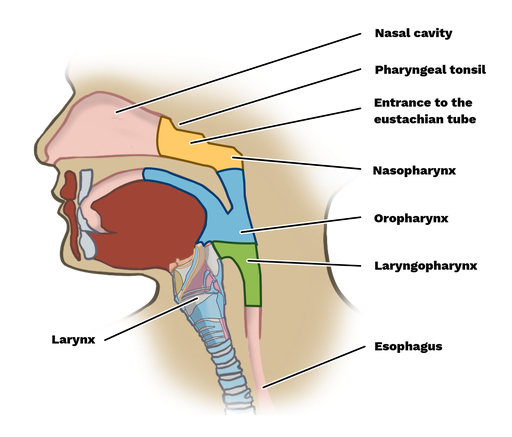Pharynx
The pharynx is a hollow, muscular passageway that interconnects the nasal cavity, oral cavity, and larynx. The pharynx is divided into the following three regions, as illustrated.
-
Nasopharynx - the region posterior to the nasal cavity, shaded yellow in the image. Unlike the nasal cavity, the nasopharynx is not divided along the midline, but is a single space that is continuous with both the right and left sides of the nasal cavity. The internal nares mark the boundary between the nasal cavity and the nasopharynx. The nasopharynx contains the pharyngeal tonsil, also known as the adenoid. Tonsils are large lymph nodes, housing white blood cells and helping to protect the body from pathogens that enter the body through the nose. The nasopharynx also contains openings to the auditory tube, to maintain the air pressure in the middle ear. The nasopharynx is continuous with the oropharynx inferiorly.
-
Oropharynx - the region posterior to the oral cavity and inferior to the nasopharynx, shaded light blue in the image. The oropharynx is commonly known as the throat. Since the oropharynx is continuous with the nasal and oral cavity, it is considered part of both the respiratory and digestive systems as it conveys both air and ingested food and beverages. The oropharynx is continuous with the laryngopharynx inferiorly.
-
Laryngopharynx - the most inferior region of the pharynx, shaded purple in the image. The inferior portion of laryngopharynx bifurcates into the esophagus posteriorly and the trachea anteriorly, marking a distinction between the respiratory and digestive systems. Therefore, like the oropharynx, the laryngopharynx conveys both air and food/beverage. In the laryngopharynx, however, it is expected that all food and fluid will pass from the laryngopharynx into the esophagus, while air will be passed into the trachea, via the larynx, on the way to the lungs.
The primary functions of the pharynx include:
- Conducting air further into the respiratory system
- Conducting food and beverages into the digestive system
- Protection from pathogens
- Equilibrating middle ear air pressure

Figure 1: A lateral view showing the key structures and three sections of the pharynx, marked in yellow, blue, and green.